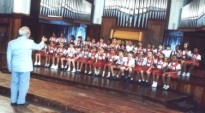11.11.3 Octavio Marín

Octavio Armando Marín, a prominent Cuban arranger, conductor, and choir singer who worked as a radio and television announcer, was born on December 29, 1929, in Havana.
His father, Oscar Marín, was a musician who worked as a copyist on the works of Roig, Olga de Blanck, Anckermann, Sánchez de Fuentes, and the Grenet brothers, among others. He was the one who guided his son’s first steps in music; together with his siblings, Roberto, Hilda, and Raquel, he formed a quartet that sang at the Church of El Pilar.
After studying at the Municipal Conservatory of Havana (Rastro No. 1 and Espada, Centro Habana, Havana), Octavio Marín began to develop as a musician, arranger, director, and choir singer. His first performances were of Juan Blanco’s Tríptico Coral and Amadeo Roldán’s El Curujey. He has made important choral arrangements of famous musical works, including Quirino con su tres, Mariposita de primavera, Tú no sabe inglé, and Yambambo, in which his interesting use of great chromaticism and complexity can be clearly seen, giving the work a contemporary feel.
Octavio Marín founded the National Polyphonic Choir under the direction of Maestro Serafín Pro in 1960; and in 1961, he created the Matanzas Choir. The following year, he joined the CMQ-TV Choir, directed by Carlos Faxas. With him, he founded the ICRT Choir in 1963, which continues under his direction to this day. He also excelled in musical productions at cabarets such as Tropicana (4504 72nd Street, Marianao, Havana), Montmartre, and the Copa Room at the Riviera (Paseo y Malecón, Vedado, Plaza de la Revolución, Havana). In the latter, he combined his work with that of great figures such as Celia Cruz, Bola de Nieve, and Nat King Cole, among many others.
He is well-remembered for his television work as director of the programs Viernes de Gala and Álbum de Cuba. In 2006, he was awarded the National Television Award.
Octavio Marín is a member of the Cuban National Choir. He also sings under the direction of Edmundo López in the Choir of the Nuestro Tiempo Cultural Society. He participates in the Philharmonic Choir, directed by Paul Czonka, and with him in the Pro Arte Musical choir, performing alongside Roberta Peters, Renata Tebaldi, Victoria de los Angeles, and Mario del Mónaco, among others. He also sings in other choral groups, including the Madrigalista Choir, the Paquito Godino Choir, and the Carmen Godoy Choir.
Currently, he adds to his intense artistic work, his work as a choral arrangement professor at the Instituto Superior de Arte (ISA) (Calle 120 No. 1110 e/ 9na y 13. Cubanacán. Playa. Havana) and the National School of Music (Calle 120 e/ 9na y 13, Cubanacán. Playa. Havana).








